Hockey drills
- Set up the exercise and where the ball is played to the team-mate it goes through the alley.
- At the end of the exercise the ball carrier can score on goal.
- After the exercise, the players walk along the outside back to the start.
- Increase the distance between them
- Make the street narrower and narrower
- change the starting position after a while

Explanation
3 (4) against 2 + goalkeeper
OrganisationField
: demarcated space (on half a field)
General
- The form starts when blue 1 passes to orange 1.
- Orange 1, 2 and 3 ( possibly 4) try to score in the goal.
- Blue 1 and 2 try, by working together, to take over possession of the ball on their strong side and then to score in one of the little goals on the centre field (circle size about 3 metres).
The form stops when:
- Orange scores in the goal.
- Blue scores in the conversion in one of the little goals on the half way line.
- The ball goes over the back line.
Exceptions:
- Ball over the sideline is a normal strike.
- Foul is a normal free hit.
Tips on ball possession
- Look before taking the ball (pre-scanning) and recognise space.
- Take free hits and hits as quickly as possible.
- Use push passes.
Tips on non-ball possession
- Work together (cover each other's backs), give pressure on the ball, keep the ball on your defensive forehand side (fake space).
- Force a pass to the back or force a pass wide; this is better than a deep pass.
- Make sure you are always between the ball and your own goal
Switching tips
- On losing the ball:
- Keep pressure on the ball straight away
- Get between the ball and your own goal as quickly as possible and help your team-mate
- On winning the ball:
- Look for the free space
- Play a confident pass or accelerate strongly yourself.
- Make it easier
- Vary the method of passing (e.g. push pass) or initial pass to another player.
- Make it more difficult
- Increase Pressure:
- Who scores the most goals in 10 ball starts);
- can Orange 1,2,3 score within 30 sec.
- Increase Pressure:
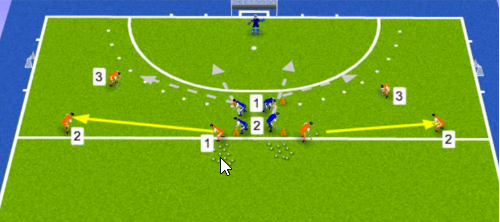
Goal: Build up by moving the ball.
Instruction:
- 1 starts with the ball and plays it to 2
- 2 plays the ball back to 1
- 1 plays the ball to 3
- 3 plays the ball to 4
- 4 starts the attack and may choose how he does this
Point of attention: The defenders try to get rid of the ball as quickly and skillfully as possible
- sprint within 30s (adjust time if necessary to level)
- back line-->23
- 23-->back line
- back line-->23
- 23-->back line
- back line-->23
- 23-->back line
- Players stand with their backs to each other.
- At a distance of 10 m from each player stands a pawn with a ball on it.
- At the whistle or START, the players run to the pawn, both grab the ball, run back to each other and hand each other the ball.
- Then the players run to the pawn with the new ball and place the ball on it.
- Then they both run back to the middle and finish with their backs to each other.
- It is possible to do this in a relay race or several times in a row.
- Two teams with substitutes, substitutions are made when a goal is scored.
- Each person defends a goal, on each field there are 5 goals,
- so there are also 5 people who defend these goals.
- If a goal is scored in your goal, you have to sit on the sidelines and you become a substitute.
- A new player (substitute) from the side enters the field and will defend the goal.
- If a goal is scored, it is 1 point.
- The team that has the most points at the end of the game is the winner.
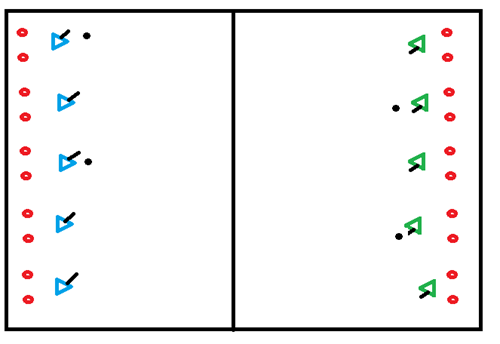
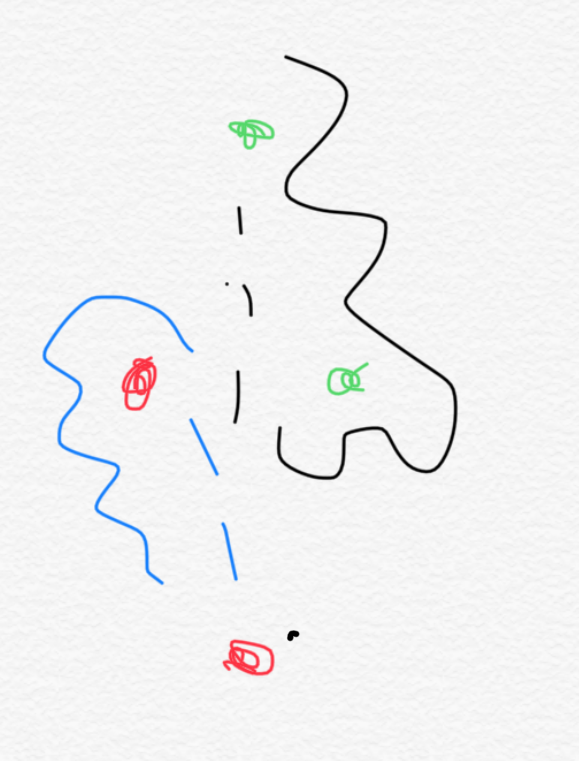
- Someone runs in from the red, takes the ball in the run and runs away strongly,
- he/she plays it to the other person who is standing near red.
- Green comes running in, takes the ball in the run and turns away strongly, playing to the other person who is standing near green.
- 2 pawns face each other,
- at a random distance (depends on whether you want to push or flatten, for example).
- Player 1 and 3 stand with pawn A.
- Player 2 stands at pawn B.
- 1 plays the ball to player 2,
- 2 receives the ball.
- After player 1 passes the ball, he runs after his ball towards pion B.
- When player 2 has passed again he runs in the direction of pion A.
- etc. etcde
- You can play this exercise with minimum 3 players, maximum 5 otherwise the intensity will be very low.
Overplaying to score
- Two players continuously play the ball over
- until one of them is so close to the goal
- that he can score in the goal.
Variation 2-1 situation:
- Under pressure from the defender, the attackers must now play together and try to score.
- The defender can score a point by conquering the ball and then dribbling over the dead ball line.
- This is the short side without a goal.
Goal
:As an attack is to get the most out of your attackAs a
defense is to defend smartly.
Set-up:
- The field is up to the dotted line.
- The attackers take the ball from somewhere on the dotted line and must try to score.
- The defenders must try to defend the ball from the outside.
- The attackers score 3 points when they score; 2 points when they force a corner and 1 point when they have a good scoring chance.
- The defenders get 3 points when they defend the ball by playing in between the pawns; 2 points when they get a free hit and 1 point when they manage to play the ball over the touchline.
NB When defenders score, the ball does not have to be run between the pawns or accepted behind the pawns.
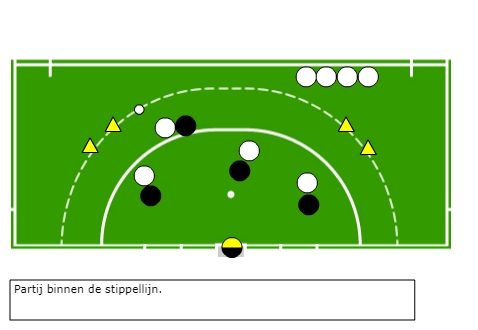
Variations:
- Adjust the size of those teams according to the amount of players available. You can also have one team on the sidelines and play a 2 to 3 minute game each time. That way there is a break and the players have time to discuss and analyse.
- The scoring pawns for the defenders can also be made smaller.
- You can play with a 'chameleon' and thus give the attackers an overtal when scoring is not going well.
Points of attention:
- Make sure it is clear who is picking up which man.
- As defenders, try to keep a low profile and prevent fouls.
- As the attackers, try to actively look for a foot.
- Look for opportunities to double-team When you, as the defender, realise that your man is not being active enough in the attack, help your buddy defend and push the attacker into a corner
- As the attacker, look for the backhand of your opponent. A right-wing attack is therefore often easier to execute than the other way around
- divide the team by 2 and run it.
- Sit on top and blow the whistle on any fouls called
- so they get used to it.
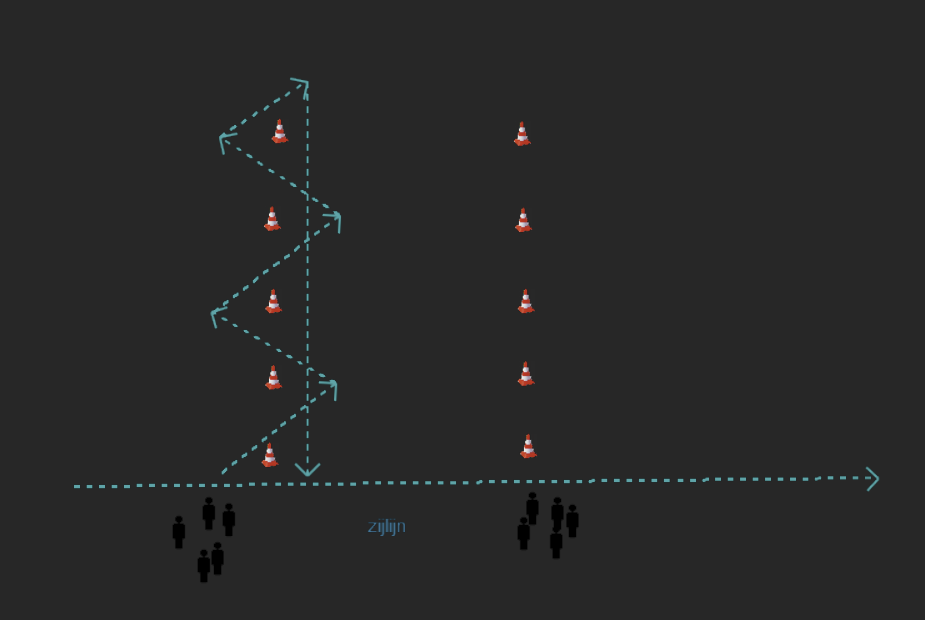
- A slalom exercise
- watch how the hands are holding the stick
- where they have the ball
- And if they use the stick properly when they run through the exercise!
- If it goes well, you can make a game of it and see if they master this. The team that has been through all the exercises first has won.








